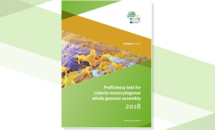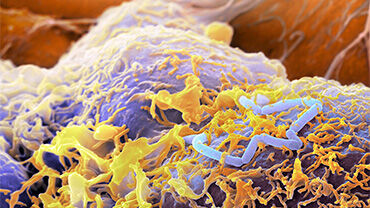Eighth external quality assessment scheme for Listeria monocytogenes typing
This report presents the results of the eighth round of the external quality assessment (EQA-8) scheme for Listeria monocytogenes (L. monocytogenes) typing, organised for national public health reference laboratories (NPHRLs) providing data to the Food- and Waterborne Diseases and Zoonoses Network (FWD-Net), managed by ECDC. Since 2012, the Section for Foodborne Infections at Statens Serum Institut (SSI) in Denmark has arranged the EQA under a framework contract with ECDC. EQA-8 contains serotyping, and molecular typing-based cluster analysis.
Executive summary
Human listeriosis is a relatively rare but serious foodborne disease with a European Union (EU) notification rate of 0.46 cases per 100 000 population in 2019 [3]. The number of human listeriosis cases in the EU has increased from 2008 to 2016. During the period 2017−2019, the level of reported cases was stable. Since 2007, ECDC has been responsible for EU-wide surveillance of listeriosis, including facilitating the detection and investigation of food-borne outbreaks. Surveillance data, including certain basic typing parameters, are reported by European Union/European Economic Area (EU/EEA) countries to the European Surveillance System (TESSy). Since 2012, the EQA scheme has covered molecular typing methods used for EU-wide surveillance.
The effective molecular typing-enhanced surveillance relies on the capacity of NPHRLs in the FWD-Net to produce comparable typing results. ECDC has opened up the possibility for countries to submit WGS data for L. monocytogenes to TESSy for to be use in EU-wide surveillance and cross-sectoral comparison. The previous EQA schemes (EQA-1 to EQA-4) included quality assessment of the pulsed-field gel electrophoresis (PFGE) performed for L. monocytogenes. Since EQA-5, the PFGE part has been modified to only assess the ability to identify a cluster using the PFGE method and the quality assessment part has been excluded.
The objectives of the EQA are to assess the quality and comparability of typing data reported by NPHRLs participating in FWD-Net. Test isolates for the EQA were selected to cover isolates currently relevant for public health in Europe and to represent a broad range of clinically relevant types of invasive listeriosis. Two sets of 11 test isolates were selected for serotyping and molecular typing-based cluster analysis. Eighteen laboratories signed up and 17 completed the exercise, representing a decrease in participation of three laboratories (18%) compared to EQA-5, but the same level of participation as EQA-6 and EQA-7. The majority of participants (11/17; 65%) completed the full EQA scheme.
In total, 13 (76%) laboratories participated in the serotyping part. Molecular serogrouping results were provided by 11 of 13 (85%) participants. Two participants performed both conventional serotyping and molecular serogrouping. The performance of molecular serogrouping was high, with 99% correct results. For the conventional method, 75% of the participants correctly serotyped all test isolates. One participant mistyped eight of the 11 isolates. Since the first EQA in 2012, a trend towards substituting conventional serotyping with molecular serogrouping has been observed.
Of the 17 laboratories participating in the EQA-8, 15 (88%) performed molecular typing-based cluster analysis using a method of their choice. The idea of the cluster analysis part of the EQA was to assess the NPHRLs’ ability to identify a cluster that was genetically closely related - i.e. to correctly categorise the cluster test isolates regardless of the method used, instead of the ability to follow a specific procedure.
The cluster of closely-related isolates was pre-defined by the EQA provider using WGS derived data. Therefore, as expected, the correct cluster delineation was difficult to obtain using less discriminatory methods (e.g. PFGE). Neither of the two participants using PFGE identified the cluster correctly. Fourteen laboratories performed cluster analysis using WGS-derived data. Performance was high, with 100% of the participants correctly identifying the cluster of closely-related isolates. An allele-based method was preferred, since 86% (12/14) used core genome multilocus sequence typing (cgMLST), while only 14% (2/14) using single nucleotide polymorphism (SNP). The most widely used scheme for the EQAs was the Ruppitsch (cgMLST), however the Pasteur scheme (cgMLST) was still used by 33% (5/15) of the participants in EQA-8.
In EQA-5 to EQA-8, participants were free to choose their preferred analytical method for the WGS-based cluster identification. The conclusion from EQA-5 was that cgMLST has higher consistency than SNP analysis. However, the conclusion was not as obvious in EQA-6, EQA-7 or EQA-8, since only a few SNP analyses were reported in these schemes compared with six SNP analyses in EQA-5.
In EQA-8, the EQA provider introduced an additional part to the molecular typing-based cluster analysis: an assessment of five genomes provided for the EQA. The idea was to mimic an urgent outbreak situation, where sequence data may have been produced in other laboratories and the available sequences would have to be addressed despite possibly being poor quality. Almost all participants successfully identified the two high-quality genomes as either a cluster isolate (Fasta file 93%) or a non-cluster isolate (93%). Both poor-quality genomes were identified by 93% of the participants. Only 50% of the participants identified the genome with 15% L. monocytogenes ST1 contamination.
Download






